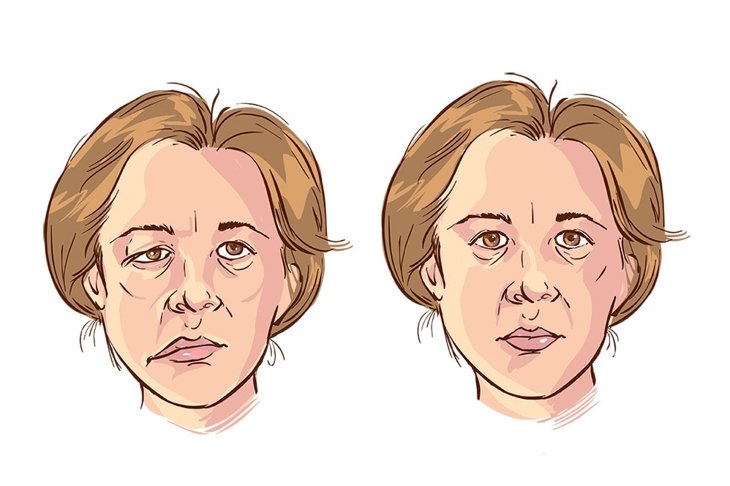
When we look in a mirror, we expect to see our facial features aligned in a particular way. But Bell\’s palsy rearranges that image.
After my swim, I stood in the middle of the open shower area and asked, “Does anyone have shampoo I could borrow?” It came out more twisted sounding than that, given my mouth was paralyzed by Bell’s palsy, but the request was clear enough.
Instead of some kind stranger squirting a dollop of shampoo into my palm, six ladies looked at my crooked face and either turned their backs or snapped their shower stall curtains shut. Just then a mentally challenged woman leaving for the locker room put a small bottle in my hand. “Here, you can have this,” she said.
An unusual headache
Four days earlier I’d developed the worst headache of my life—a hot, strange pain that ran from the top of my head down my neck and back. The next day I’d felt muscle spasms in my left cheek. Two mornings later, I chomped down on the inside of my cheek while trying to spoon cereal into my mouth. I sipped orange juice and it spilled onto my pajama top. I looked in the mirror. The left side of my mouth drooped down. I blinked. Only my right eye closed.
We were on vacation at our cottage, so I went to the nearest emergency room. On June 30, 2014, at Brockville General Hospital, I was diagnosed with Bell’s palsy, an inflammation of the seventh cranial nerve possibly caused by a virus.
A week of prednisone was prescribed. I had to tape my paralyzed left eye shut at bedtime to prevent drying out of the cornea. For the first two weeks, I couldn’t close my mouth. Tears dripped out of my paralyzed eye. The paralysis in my left ear made me feel off-balance. I wore wraparound sunglasses to protect my frozen-open eye from dirt and wind, but the July sun was too bright and my eye too vulnerable for me to spend much time outside.
A silver lining
Nevertheless, it was a magical time, because I discovered facial reflexology. Every few days my long-time cottage neighbour and facial reflexologist Audrey Harkness, who’s been doing reflexology for many years, massaged my back and neck, then did reflexology on my face, ending the treatment with some deep breathing. (Facial reflexology is based on the theory that by stimulating points and reflex zones on the face it is possible to promote a state of equilibrium and balance in the body.)
I cannot prove the facial reflexology treatments helped my paralysis recede more quickly and completely, but I do know how wonderfully healing these treatments felt, how much I appreciated the beauty of the river and trees while walking home from my neighbour’s place, how relaxed I was for the rest of the day, and how wrinkle-free and glowing each treatment left my face.
It’s been a year since my diagnosis. I’ve recovered. My mouth still pulls ever so slightly to one side, and my left eyelid droops almost imperceptibly. Fortunately, I can smile again, and when I do, all signs of my Bell’s palsy disappear.
Bell’s palsy FAQs
What is Bell’s palsy?
It’s a temporary facial paralysis of one side of the face that results from damage or trauma to the facial nerve (the seventh cranial nerve). Paralysis to both sides of the face is rare.
What causes it?
The facial nerve becomes swollen, compressed, or inflamed; however, what causes this is unknown. Possible causes include viral infection, such as the herpes simplex virus or the common cold virus; headache; chronic middle ear infection; high blood pressure; diabetes; Lyme disease; and trauma or injury to the face or skull.
Who gets it?
One in 60 people will develop Bell’s palsy, with men and women equally affected. Most cases occur between the ages of 20 and 40. Although it’s less common over the age of 60, older people have a greater risk of long-term health effects.
What are the symptoms?
Symptoms vary from mild weakness to total paralysis of one side of the face, and may include
- twitching or weakness in the face
- drooping corner of the mouth or eyelid
- drooling
- dry eye or mouth
- loss of taste
- impaired speech
- dizziness
- ringing in the ears
- headache
How is it treated?
Medical treatment: The first Canadian Bell’s palsy treatment guideline was published in the Canadian Medical Association Journal in 2014. Recommendations include the use of exercise physiotherapy to treat persistent facial weakness.
Eye care: It may be necessary to wear an eye patch or tape the eyelids shut while sleeping to protect the cornea. Artificial teardrops and ointments are used to keep the cornea moist.
Alternative treatments: Facial reflexology, facial massage, or acupuncture may provide pain relief and improve facial nerve function.
What is the prognosis?
Most people recover gradually, often showing improvement within two weeks after they experience symptoms. Normal facial functioning usually returns within three to six months. In rare cases, the symptoms may be permanent.



